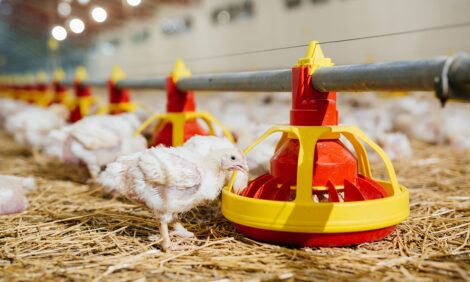



Application of Genomic Selection Using an Evenly Spaced Low-density Marker Panel in Broiler Chickens
Genomic selection can be implemented with low-density marker panels combined with imputation, according to researchers based at Iowa State University.In this study, a commercial broiler chicken line was
used to verify the feasibility and accuracy of genomic
selection using an evenly spaced low-density marker panel.
Body weight and hen house production (the cumulative egg
production over the laying period, up to 22 weeks or until
culled) were used as example traits.
The training population
included 2,302 birds, of which 1,259 were genotyped using
a high-density marker panel with 36,455 markers across the
genome, and the other 1,043 birds were genotyped with a
low-density marker panel with 384 markers.
The validation
population included 3,720 birds genotyped with the low-density
marker panel. A rule-based method combined with a
Gibbs sampler was used to impute missing genotypes for
the birds genotyped at low-density. Several methods were
employed to predict genomic estimated breeding values for
validation birds.
Results showed that accuracy of genomic
prediction was seven to eight per cent than estimated breeding
values from pedigree for body weight, and four per cent higher for
hen house production.
The authors concluded that genomic selection
can be implemented with low-density marker panels
combined with imputation.
The report, published in Iowa State University Animal Industry Report 2013 (A.S. Leaflet R2807) was written by Chunkao Wang, David Habier and Anna Wolc (all Postdoctoral Research Associates) and Professors Dorian J. Garrick, Rohan L. Fernando, Susan J. Lamont and Jack C.M. Dekkers, all of Iowa State University; and Andreas Kranis, Kellie A. Watson and Santiago Avendano of Aviagen Ltd in the UK.
Introduction
The use of evenly spaced low-density (ELD) marker panels with imputation to implement genomic selection (GS) can result in large reductions in genotyping costs. The effectiveness of this strategy has been studied using simulation but must be verified in practice. Moreover, whether ELD-genotyped individuals can be used in training data must also be evaluated.
Materials and Methods
A high-density (HD) marker panel including 36,455
SNP markers across the genome was used to genotype 1,259
birds in a commercial broiler chicken line by Aviagen Ltd.
A total of 20,630 SNPs were kept for analyses after edits for
marker quality. Based on the HD genotypes, an ELD-marker
panel was created with 384 SNPs and used to
genotype an additional 1,043 birds and 3,760 progeny. A
rule-based method was used to infer haplotypes of HD-genotyped
individuals. A Gibbs sampler was employed to
estimate allele segregation probabilities of ELD-SNPs for
the ELD-genotyped birds. Then the missing HD genotypes
in ELD-genotyped birds were imputed.
The 1,259 HD-genotyped
and 1,043 ELD-genotyped birds were used as
training data and the 3,760 ELD-genotyped birds as
validation data. Methods Bayes-A, -Cπ, -B (using the
estimated π from Bayes-Cπ) and GBLUP were used to
estimate marker effects using Gensel 4.23R software that
was developed at Iowa State University.
The estimates of
marker effects were used to compute genomic estimated
breeding values (GEBV) of the validation individuals.
The
accuracy of GEBV prediction was calculated based on the
correlation of GEBVs with adjusted phenotypes of the
validation individuals.
Results and Discussion
For bodyweight, the accuracy from GEBV by GS prediction methods was 0.07 to 0.08 higher than the accuracy of EBV from pedigree BLUP (PBLUP); for hen house production, the accuracy of GEBV was 0.04 higher than the accuracy of PBLUP (Table 1).
| Table 1. Accuracy of Estimated Breeding Values (EBV) in the validation population | |||||
|---|---|---|---|---|---|
| Method | |||||
| Trait | Bayes-A | Bayes-Cπ1 | Bayes-B | GBLUP | PBLUP |
| Body weight | 0.33 | 0.33 | 0.32 | 0.32 | 0.25 |
| Hen house production | 0.21 | 0.21 | 0.21 | 0.21 | 0.17 |
| 1 π was estimated to be 0.92 for body weight and 0.96 for hen house production | |||||
For body weight, the correlation of GEBVs among GS prediction methods was greater than 0.96; the correlation of EBV from PBLUP with GEBV was about 0.62 for all GS prediction methods. For hen house production, the correlation of GEBVs among GS prediction methods was greater than 0.98; the correlation of EBV from PBLUP with GEBV was about 0.73 for all GS prediction methods.
Acknowledgments
The authors gratefully acknowledge the funding support from Aviagen Ltd and SABRE Demonstration Funds of EU Framework 7.
February 2013








